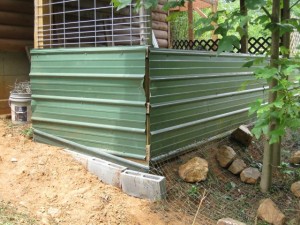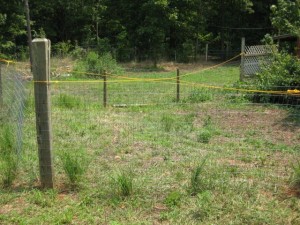A few evenings ago, after locking the chicks in the pen, I heard an unusual noise and went to investigate. The coop is divided by an inner partition. The two Golden Comets were on the one side on the roosting perch, which didn’t surprise me since from the get go they were ostracized and even though now they appear to be accepted, they still act independently. On the other side of the partition I saw an unusual sight – the other six chicks appeared to be shoving and tugging to get into a corner of the coop. It appeared each one’s efforts was to get to the bottom of the scrum for even when one climbed on top of the melee it wasn’t satisfied until it had dislodged those below it and was situate on the bottom in the corner. What was just as interesting was that the two Golden Comets, who had followed me, immediately joined in the proceedings. It was a continuously revolving spectacle. I dislodged them momentarily and examined the corner and there was nothing unusual about it, to explain their intense need to access it.
As I pondered, there came to mind a similar event which occurred the previous December. On a mild winter’s day I had examined the hive to check their food situation and inadvertently dislodged some 40 bees which immediately formed a cluster on a plank. I placed the plank at the hive entrance and expected them to move the 6 inches or so into the hive. But they stayed in their cluster, which I saw when I moved closer, was in continuous motion with bees underneath coming to the surface to be replaced by the bees on the surface. I left them there assuming, when they had concluded their activities, they would move into the hive. The next morning, the little cluster of bees was still on the plank, frozen in place. I did not realize they were desperately trying to keep themselves warm, as they do in their hive during the winter, and that what I was watching was desperation and panic.

So with this lesson in mind, I continued to study the chicks and came to the conclusion that the reason each one was struggling to get to the bottom of the corner was because this was the safest place to be from a predator. So something had spooked them. I reexamined their little fully enclosed courtyard and decided that the hole under a piece of concrete which I had assumed they had made for sunbathing or dusting purposes, should be more closely examined. In fact it turned out to be a tunnel and on the outside of the coop I found the entrance hole to the tunnel. The tunnel was some 4 feet in length and maybe 6″ to 8″ in diameter. My fortuitous visit had interrupted what may have been a disastrous evening. I plugged the tunnel and placed cinder blocks all round the coop perimeter. I had known predators are motivated and can and will dig, but had assumed that the 4″ depth of the perimeter wall/fence would have provided adequate protection.

My neighbor who introduced me to chickens has agreed to give me her 6 mature girls – 4 hybrids, 1 Americauna and 1 Rhode Island Red. Since her girls, which regularly produce 4 eggs daily, are much larger than my 14 week flock, I must keep them separate, which means building them their own coop and outdoor exercise area. With my enhanced respect for the wiles of predators, I am reinforcing the adjoining woodshed which will become the new coop. Because it is situated on a slope, which means even if I put down a 1 ft vertical barrier the invader could probably tunnel under, I have decided to lay horizontally a 4 ft wire wrought fence, which is held in place by surplus 10″ steel tent stakes and rocks. Much work still remains before the coop is ready for service.

While walking the adjacent woods early in the morning we startled a Great Horned Owl. This got me thinking about the need to protect the chicks from aerial attack by hawks or this big owl. So I cross laced the fenced exercise area with yellow rope which I hope will complicate and deter any aerial strategies.

Do you foresee being able to integrate your neighbor’s chickens with your current flock at some point in the future?
I hope so. Both flocks have established pecking orders. Amongst my neighbor’s hens, the Rhode Island Red is the top chicken and the Americauna is the bottom chicken (incidentally the Americauna is one of the larger birds but may have become demoralized from the loss of the other Americauna a month ago). The Rhode Island Red is the smallest of the birds but is very intelligent, quick and aggressive and this seems to cower the group. Amongst our flock, which is 7 hens and 1 rooster, Buffy (the Buff Orpington rooster) is coming into his own and putting on displays to intimidate the others. Buffey’s id would experience a setback if he were suddenly introduced to the much bigger girls. More importantly the two established pecking orders would have to be integrated and rationalized and the smaller birds could be harmed. So my thought is for the next few months to keep them separate. My coop is on the north exposed side of the barn, which is unfortunate since it catches the summer sun, which we don’t need since it is more than hot enough in summer. Conversely the barn and pine trees block exposure to the lower elevated winter son, which we will need during the colder months. My thought is to construct a single new coop in time for December which is better placed, sun wise. Therefore my hope is that by November, the two flocks can become room mates.